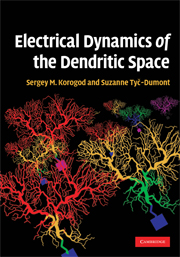Book contents
- Frontmatter
- Contents
- Preface
- 1 Definition of the neuron
- 2 3D geometry of dendritic arborizations
- 3 Basics in bioelectricity
- 4 Cable theory and dendrites
- 5 Voltage transfer over dendrites
- 6 Current transfer over dendrites
- 7 Electrical structure of an artificial dendritic path
- 8 Electrical structure of a bifurcation
- 9 Geography of the dendritic space
- 10 Electrical structures of biological dendrites
- 11 Electrical structure of the whole arborization
- 12 Electrical structures in 3D dendritic space
- 13 Dendritic space as a coder of the temporal output patterns
- 14 Concluding remarks
- Index
- References
9 - Geography of the dendritic space
Published online by Cambridge University Press: 03 May 2010
- Frontmatter
- Contents
- Preface
- 1 Definition of the neuron
- 2 3D geometry of dendritic arborizations
- 3 Basics in bioelectricity
- 4 Cable theory and dendrites
- 5 Voltage transfer over dendrites
- 6 Current transfer over dendrites
- 7 Electrical structure of an artificial dendritic path
- 8 Electrical structure of a bifurcation
- 9 Geography of the dendritic space
- 10 Electrical structures of biological dendrites
- 11 Electrical structure of the whole arborization
- 12 Electrical structures in 3D dendritic space
- 13 Dendritic space as a coder of the temporal output patterns
- 14 Concluding remarks
- Index
- References
Summary
Biological neurons have complex and diverse shape and size, which are mainly defined by their dendritic arborization (see Chapter 2). Considering the complex arborizations given by nature one can recognize the elementary structures considered in Chapters 7 and 8. The uniform segments, symmetrical or, more often, asymmetrical bifurcations as structural components are present in biological arborizations en masse and in various, unpredictable combinations. The geometrical information required for building the electrical structure of biological dendrites is the same as for the elementary artificial dendritic structures: the branching pattern, lengths and diameters of the branches, whereas the 3D organization does not matter. In the 3D biological arborization, because of the complexity all these structural details are seen hardly if at all, and so retrieving and relating the structural and electrical features are hampered. To deal with this problem we have to separate different aspects of geometry of the dendritic space.
One aspect could be considered as intrinsic, irrelevant of the 3D arrangement of a neuron in the space of the brain or spinal cord. The components of the dendritic structure are characterized only in terms of their lengths and diameters. The multiplicity of the structural components (paths, branches and bifurcations) imparts the complexity to the biological dendrites. In a given arborization, one meets unpredictably connected branches with unpredictably varying lengths and heterogeneous diameters and, in that sense, the dendritic geometry is stochastic both topologically and metrically.
- Type
- Chapter
- Information
- Electrical Dynamics of the Dendritic Space , pp. 113 - 126Publisher: Cambridge University PressPrint publication year: 2009



